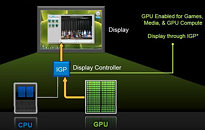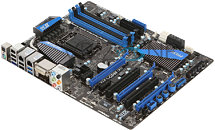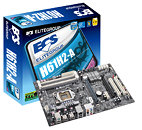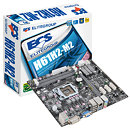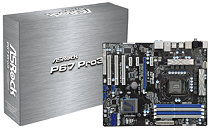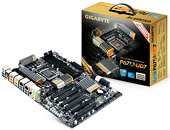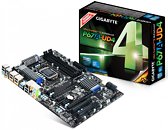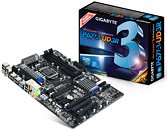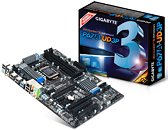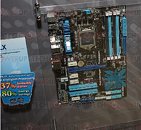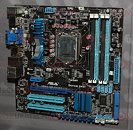Apr 16th, 2025 08:52 EDT
change timezone
Latest GPU Drivers
New Forum Posts
- Last game you purchased? (771)
- GPU Memory Temprature is always high (16)
- Windows 11 fresh install to do list (20)
- 5070ti overclock...what are your settings? (3)
- Help For XFX RX 590 GME Chinese - Vbios (4)
- PCGH: "hidden site" to see total money spend on steam (3)
- Share your AIDA 64 cache and memory benchmark here (3053)
- NVFlash for RTX 50 Series (Blackwell) (0)
- intel 1700 with high speed ram,memory (63)
- The TPU UK Clubhouse (26115)
Popular Reviews
- G.SKILL Trident Z5 NEO RGB DDR5-6000 32 GB CL26 Review - AMD EXPO
- ASUS GeForce RTX 5080 TUF OC Review
- DAREU A950 Wing Review
- The Last Of Us Part 2 Performance Benchmark Review - 30 GPUs Compared
- Sapphire Radeon RX 9070 XT Pulse Review
- Sapphire Radeon RX 9070 XT Nitro+ Review - Beating NVIDIA
- Upcoming Hardware Launches 2025 (Updated Apr 2025)
- Thermaltake TR100 Review
- Zotac GeForce RTX 5070 Ti Amp Extreme Review
- TerraMaster F8 SSD Plus Review - Compact and quiet
Controversial News Posts
- NVIDIA GeForce RTX 5060 Ti 16 GB SKU Likely Launching at $499, According to Supply Chain Leak (182)
- NVIDIA Sends MSRP Numbers to Partners: GeForce RTX 5060 Ti 8 GB at $379, RTX 5060 Ti 16 GB at $429 (124)
- Nintendo Confirms That Switch 2 Joy-Cons Will Not Utilize Hall Effect Stick Technology (105)
- Over 200,000 Sold Radeon RX 9070 and RX 9070 XT GPUs? AMD Says No Number was Given (100)
- Nintendo Switch 2 Launches June 5 at $449.99 with New Hardware and Games (99)
- Sony Increases the PS5 Pricing in EMEA and ANZ by Around 25 Percent (85)
- NVIDIA PhysX and Flow Made Fully Open-Source (77)
- NVIDIA Pushes GeForce RTX 5060 Ti Launch to Mid-April, RTX 5060 to May (77)
News Posts matching #H67
Return to Keyword Browsing
ASRock Takes Intel Ivy Bridge CPUs to Z68, P67 and H67 Series Motherboards
World's top 3 motherboard manufacturer ASRock today announced that its entire line of Intel P67, H67 and Z68 series motherboards will support Intel Ivy Bridge CPUs by updating the latest P version BIOS & Drivers! Via an Intel Ivy Bridge CPU, ASRock P67, H67 and Z68 series motherboards are resurrected. Users may expect more powerful processing speed yet lower power consumption by the world's first 22 nm 3-D Transistors.
"Besides pursuing extremes with hardcore hardware enthusiasts and die-hard gamers, making high-end technology easy and accessible for everybody is also one of ASRock's goals." commented James Lee, V.P. of Sales and Marketing at ASRock. "We have no doubt that users will be thrilled as much as we are with these updates, it will be like experiencing a brand new motherboard all over again."
"Besides pursuing extremes with hardcore hardware enthusiasts and die-hard gamers, making high-end technology easy and accessible for everybody is also one of ASRock's goals." commented James Lee, V.P. of Sales and Marketing at ASRock. "We have no doubt that users will be thrilled as much as we are with these updates, it will be like experiencing a brand new motherboard all over again."

Colorful Announces Its First Mini-ITX Barebone for Gaming
Colorful is well-known for its highly innovative graphics card designs, it is one of China's leading graphics card brands. Some of its graphics card designs have captured our imagination. Its latest creation is a DIY mini-ITX barebones system for gaming, called Desert Eagle. The package consists of Colorful's own-design slim-form-factor (SFF) chassis, which bears a swanky combination of red and black, with ample perforations and and top handles; a custom-design, low-profile Colorfire AMD Radeon HD 6750 graphics card (Colorfire is Colorful's Radeon-selling brand); a mini-ITX socket LGA1155 motherboard based on the Intel H67 chipset (model: i-H67HD U3); and a 300W PSU.

Intel To Launch Sandy Bridge LGA1155 Processors That Lack iGPU
"Visibly Smart" was the tagline with which Intel brought its 2nd Generation Core processor family codenamed "Sandy Bridge" into the market. What every Sandy Bridge chip in the LGA1155 package launched thus far has in common is its integrated graphics controller. Apparently, Intel is planning to launch three new Core i5 quad-core processors, which lack that integrated graphics. The processors very much will work on H61, H67, and Z68 chipset-based motherboards, only you can't use the integrated graphics, making them functionally-identical to first-generation LGA1156 Core i5 quad-core chips.
The Core i5-2550K, which has been talked about for the past few weeks, is one of these three models that will lack iGPU. This chip is geared for overclocking, as it features an unlocked base clock multiplier. The other two models are the Core i5-2450P, and Core i5-2380P. Intel is perhaps counting on the "P" marker to intuitively denote lack of iGPU, like with P67 chipset. Clocked at 3.10 GHz with a Turbo Boost speed of 3.40 GHz, the Core i5-2380P is clocked identically to the Core i5-2400, except of course it lacks the iGPU. The Core i5-2450P, on the other hand is a little unique, with a clock speed of 3.20 GHz and 3.50 GHz Turbo Boost speed. Pricing and availability are not known, though it is expected that some of these chips will be priced lower than existing models with iGPU.
The Core i5-2550K, which has been talked about for the past few weeks, is one of these three models that will lack iGPU. This chip is geared for overclocking, as it features an unlocked base clock multiplier. The other two models are the Core i5-2450P, and Core i5-2380P. Intel is perhaps counting on the "P" marker to intuitively denote lack of iGPU, like with P67 chipset. Clocked at 3.10 GHz with a Turbo Boost speed of 3.40 GHz, the Core i5-2380P is clocked identically to the Core i5-2400, except of course it lacks the iGPU. The Core i5-2450P, on the other hand is a little unique, with a clock speed of 3.20 GHz and 3.50 GHz Turbo Boost speed. Pricing and availability are not known, though it is expected that some of these chips will be priced lower than existing models with iGPU.

Gigabyte Releases SATA Mode Switching Tool
Gigabyte released a new utility that allows you to change the mode of the chipset SATA controller between IDE, AHCI, and RAID (if available), from within Windows. While the switching isn't exactly on-the-fly (because changing SATA mode is effectively changing the SATA controller as Windows sees it, and hence can't happen on-the-fly), it certainly saves the trouble of going into BIOS setup and digging out that option. The utility works by writing the value of the selected mode to the CMOS, and prompting a system reboot for the change to take effect. Gigabyte's Disk Mode Switch utility works on Gigabyte motherboards based on Intel 6-series chipset (H61, H67, P67, and Z68). Now why you'd need a Windows-based utility to change a BIOS setting as infrequently changed as SATA controller mode is something we'll leave it to you to comment on.DOWNLOAD: Gigabyte Disk Mode Switch

GIGABYTE Announces Entire 6 Series Ready to Support Native PCIe Gen. 3
GIGABYTE TECHNOLOGY Co., Ltd, a leading manufacturer of motherboards, graphics cards and computing hardware solutions today announced their entire range of 6 series motherboards are ready to support the next generation Intel 22nm CPUs (LGA1155 Socket) as well as offer native support for PCI Express Gen. 3 technology, delivering maximum data bandwidth for future discrete graphics cards.
Wanting to provide maximum upgradeability to customers, GIGABYTE has enabled native support for PCI Express Gen. 3 across the entire range of GIGABYTE 6 series motherboards, including the recently launched G1.Sniper 2 motherboard, when paired with Intel's next generation 22nm CPUs. By installing the latest BIOS for their 6 series motherboards today, users can be assured they are ready to take advantage of all the performance enhancements tomorrow's technologies have to offer.
Wanting to provide maximum upgradeability to customers, GIGABYTE has enabled native support for PCI Express Gen. 3 across the entire range of GIGABYTE 6 series motherboards, including the recently launched G1.Sniper 2 motherboard, when paired with Intel's next generation 22nm CPUs. By installing the latest BIOS for their 6 series motherboards today, users can be assured they are ready to take advantage of all the performance enhancements tomorrow's technologies have to offer.

NVIDIA to Launch Optimus-like Technology for Desktops at Computex 2011
While NVIDIA and AMD are just about done with their consumer GPU launches for the current generation, NVIDIA has something in store for Computex, 2011, one of the year's biggest technology tradeshows. The GPU giant will announce NVIDIA Optimus technology's desktop avatar, for now known as "Synergy". The technology allows on-the-fly switching between a computer's integrated graphics and discrete NVIDIA GeForce graphics processor, giving you access to the feature-set of both, and allowing a fair amount of power-saving in the process.
NVIDIA's new technology is designed specifically for Intel's Sandy Bridge desktop platform, particularly motherboards with Intel H61, H67, and Z68 chipsets (you can't access IGP with P6x). Unlike SLI, motherboard vendors needn't shell out a license fee or sign an agreement to implement the technology. A supportive motherboard will have authorization code implanted into SBIOS, much like SLI. In practice, the technology will allow users to switch to a GeForce GPU (or a pair of GPUs on Z68) when gaming or in 3D-heavy applications; while falling back to the power-efficient IGP or even making use of Intel's QuickSync technology, when not gaming.
NVIDIA's new technology is designed specifically for Intel's Sandy Bridge desktop platform, particularly motherboards with Intel H61, H67, and Z68 chipsets (you can't access IGP with P6x). Unlike SLI, motherboard vendors needn't shell out a license fee or sign an agreement to implement the technology. A supportive motherboard will have authorization code implanted into SBIOS, much like SLI. In practice, the technology will allow users to switch to a GeForce GPU (or a pair of GPUs on Z68) when gaming or in 3D-heavy applications; while falling back to the power-efficient IGP or even making use of Intel's QuickSync technology, when not gaming.

Lucid Virtu to Be Licensed on Select Genuine Intel Desktop Boards with H67 and Z68
Marking a major customer engagement with Intel, LucidLogix today announced that its Virtu GPU virtualization software will be integrated into various SKUs of Genuine Intel Desktop Boards based on the Intel H67 and Z68 chipsets. Virtu allows the systems to simultaneously take full advantage of both the low-power best-in-class media processing features of the 2nd generation Intel Core processor graphics and the 3D gaming performance of add-in cards with graphics processing units (GPU).
"Intel is the world leader in CPU technology and a globally trusted brand, therefore their choice of the Virtu solution is a testament to the quality performance and integration of the technology," said Offir Remez, president and founder of LucidLogix. "The best thing about this collaboration is that the end user is the real winner. Intel H67 and Z68 desktop board owners will enjoy both a media and a high end graphics platform that is more powerful than ever seen before."
"Intel is the world leader in CPU technology and a globally trusted brand, therefore their choice of the Virtu solution is a testament to the quality performance and integration of the technology," said Offir Remez, president and founder of LucidLogix. "The best thing about this collaboration is that the end user is the real winner. Intel H67 and Z68 desktop board owners will enjoy both a media and a high end graphics platform that is more powerful than ever seen before."

MSI Z68A-GD80 (B3) Motherboard Pictured
Here are the first pictures of MSI Z68A-GD80 (B3), the company's first socket LGA1155 motherboard based on Intel's new Z68 PCH. Intel is weeks away from launching the Z68 PCH, which is a middle-ground between P67 and H67. P67 let you overclock, while it didn't feature Flexible Display Interface (FDI); H67 featured FDI, but didn't let you overclock. Z68 features FDI, it also lets you overclock to the potential of P67. MSI's Z68A-GD80 makes use of the B3 revision of the Z68 PCH. It intends to offer loads of overclocking features, ample discrete GPU expansion, as well as FDI connectivity to let you use the processor-embedded graphics.
The LGA1155 socket supports 2011 Core i5/i7 "Sandy Bridge" processors. The LOTES-made socket on the Z68A-GD80 is powered by a 15-phase VRM that uses "solid-state" chokes that don't buzz on load. The VRM is cooled by two heatsinks that share heat over a heat pipe. The socket is wired to four DDR3 DIMM slots that support dual-channel memory. Expansion slots include three PCI-Express x16 (electrical x16/NC/x4 or x8/x8/x4), two PCI-E x1, and two PCI.
The LGA1155 socket supports 2011 Core i5/i7 "Sandy Bridge" processors. The LOTES-made socket on the Z68A-GD80 is powered by a 15-phase VRM that uses "solid-state" chokes that don't buzz on load. The VRM is cooled by two heatsinks that share heat over a heat pipe. The socket is wired to four DDR3 DIMM slots that support dual-channel memory. Expansion slots include three PCI-Express x16 (electrical x16/NC/x4 or x8/x8/x4), two PCI-E x1, and two PCI.

ZOTAC Announces the H67-ITX has Resumed Shipping to Distributors and Resellers
ZOTAC International, a leading innovator and the world's largest channel manufacturer of graphics cards, motherboards and mini-PCs, today announces shipments of the H67-ITX WiFi has resumed across the globe. New shipments of the ZOTAC H67-ITX WiFi feature the updated H67 B3 revision chipset for enhanced SATA performance and reliability.
"ZOTAC values our customers and are doing everything we can to ensure customers only receive enhanced H67-ITX WiFi motherboards. To eliminate confusion, we have assigned the enhanced model with a new SKU - H67ITX-C-E," said Carsten Berger, marketing director, ZOTAC International.
"ZOTAC values our customers and are doing everything we can to ensure customers only receive enhanced H67-ITX WiFi motherboards. To eliminate confusion, we have assigned the enhanced model with a new SKU - H67ITX-C-E," said Carsten Berger, marketing director, ZOTAC International.

ECS Introduces its Intel H61 Chipset-based Motherboard Lineup
Elitegroup Computer Systems (ECS) as the pioneer in the motherboard industry with the best quality and the leading position introduces the latest Intel○R H61 series express chipset motherboards. With ECS H61 series motherboards, ECS presents the complete motherboard options powered by P67, H67 and H61 express chipsets supporting the 2nd generation Intel Core processor family. The complete series family provides plentiful choices for users from heavy-gaming need to entry-level requirement. At the same time, Intel also releases the new Sandy Bridge Dual-core processors for users to have more solution plans with less price.
With the newest B3 stepping chipset, users can fully enjoy the SATA 3 Gb/s performance without worrying about degrade performance due to previous B2 stepping chipset. ECS introduces a series of H61 motherboards - H61H2-M, H61H2-M2, H61H2-M3, H61H2-M5, H61H2-I2 and H61H2-A with affordable price and great performance. H61 series integrated with Intel HD Graphics support users to enjoy entertainment moment without a discrete graphic card; meanwhile, it helps to lower power consumption and heat production with adopting the latest dual-core processors. ECS H61 series all equip with smart and useful applications- eJIFFY / eBLU / eDLU / eSF to provide users more convenient computer-using experience.
With the newest B3 stepping chipset, users can fully enjoy the SATA 3 Gb/s performance without worrying about degrade performance due to previous B2 stepping chipset. ECS introduces a series of H61 motherboards - H61H2-M, H61H2-M2, H61H2-M3, H61H2-M5, H61H2-I2 and H61H2-A with affordable price and great performance. H61 series integrated with Intel HD Graphics support users to enjoy entertainment moment without a discrete graphic card; meanwhile, it helps to lower power consumption and heat production with adopting the latest dual-core processors. ECS H61 series all equip with smart and useful applications- eJIFFY / eBLU / eDLU / eSF to provide users more convenient computer-using experience.

Spot Signs of SATA Performance Degradation on Cougar Point P67/H67 Chipsets
Apparently there's a "slim" chance of users actually being affected by the recently-discovered chipset design error plaguing Intel's Cougar Point 6-series chipsets that drive the SandyBridge processors. Intel pegs this at 5% performance degradation caused due to data transfer errors over a period of 3 years. Users of Romanian tech community Lab 501 found out a way of detecting if your hard drives connected to the damage-prone SATA ports are already showing signs of errors.
To do so, you need the HD Tune Pro software, you can try out the Pro version. Select a hard drive connected to the damage-prone SATA 3 Gb/s port, click on the "Health" tab. HD Tune checks out various self-diagnostic parameters of the drive, including SMART values. A drive connected to an affected port should fail a number of tests as shown in the screenshot below. As a stopgap solution, you can connect the drive to one of the SATA 6 Gb/s ports available. Most motherboards should have 2 internal 6 Gb/s ports, some have additional 6 Gb/s ports driven by 3rd party controllers. It's advisable to use ports of those controllers. This stopgap fix should pull you through till April-May, when motherboard vendors are expected to have motherboards with B3 revision of the Cougar Point chipset. You can then claim replacement of your board under warranty.
To do so, you need the HD Tune Pro software, you can try out the Pro version. Select a hard drive connected to the damage-prone SATA 3 Gb/s port, click on the "Health" tab. HD Tune checks out various self-diagnostic parameters of the drive, including SMART values. A drive connected to an affected port should fail a number of tests as shown in the screenshot below. As a stopgap solution, you can connect the drive to one of the SATA 6 Gb/s ports available. Most motherboards should have 2 internal 6 Gb/s ports, some have additional 6 Gb/s ports driven by 3rd party controllers. It's advisable to use ports of those controllers. This stopgap fix should pull you through till April-May, when motherboard vendors are expected to have motherboards with B3 revision of the Cougar Point chipset. You can then claim replacement of your board under warranty.

ECS Introduces New Black Deluxe H67H2-M Motherboard, Delivers Real 3D Experience
Elitegroup Computer Systems (ECS) introduces the latest Intel based motherboard -ECS Black Deluxe H67H2-M motherboard is powered by Intel H67 express chipset supporting the 2nd generation Intel Core processor family. And ECS innovative features are specially designed for 3D home theater.
ECS Black Deluxe H67H2-M motherboard provides unbelievable gaming performance without installing discrete graphics card, by fully supports Intel HD Graphics technology, ECS Black Deluxe H67H2-M motherboard surpasses last generation platform up to 200%. Further, users are able to over clock the speed of integrated graphics cores up to 235%, which offers amazing capability to conquer 3D action games.
ECS Black Deluxe H67H2-M motherboard provides unbelievable gaming performance without installing discrete graphics card, by fully supports Intel HD Graphics technology, ECS Black Deluxe H67H2-M motherboard surpasses last generation platform up to 200%. Further, users are able to over clock the speed of integrated graphics cores up to 235%, which offers amazing capability to conquer 3D action games.

Corsair Offers the Ultimate Performance Components for Intel SandyBridge Platforms
Corsair, a worldwide designer and supplier of high-performance components to the PC gaming hardware market, today announced that it has developed a range of performance components that fully exploit the potential of the new Intel 2nd Generation Core Processor family, including the new LGA1155 Core i5 and Core i7 processors.
These components include the previously announced Corsair Vengeance DDR3 memory modules, which operate with a low VDIMM voltage of 1.5V, and include XMP-certified performance profiles for Core i5 and Core i7 processors. In addition, Corsair is also announcing the next-generation Performance 3 Series, a new range of solid-state drives, based on the Marvell 9174 controller and designed to take full advantage of the SATA 6Gbps (SATA Revision 3.0) support native to the new Intel chipsets.
These components include the previously announced Corsair Vengeance DDR3 memory modules, which operate with a low VDIMM voltage of 1.5V, and include XMP-certified performance profiles for Core i5 and Core i7 processors. In addition, Corsair is also announcing the next-generation Performance 3 Series, a new range of solid-state drives, based on the Marvell 9174 controller and designed to take full advantage of the SATA 6Gbps (SATA Revision 3.0) support native to the new Intel chipsets.

G.Skill Launches Its RipjawsX Series Memory Designed for Intel Sandy Bridge
G.Skill has announced the development of its brand new RipjawsX series memory modules, designed specifically for Intel Sandy Bridge LGA1155 processors, and H67 and P67 motherboard platforms. The new RipjawsX series consists of a complete range of memory solution, from DDR3 1,333MHz, 1,600MHz, 1,866MHz, 2,133MHz, 2,200MHz to 2,300MHz. Combined with the Intel's highly anticipated Sandy Bridge platform, G.Skill RipjawsX series memory kits deliver more bandwidth and performance than ever. The following screen shows ultimate 25K MB/s bandwidth at extreme memory speed of 2300MHz CL7.
Building on the strong success of the first generation Ripjaws brand in performance memory kits, every single RipjawsX memory kit is hand-tested on an Intel Sandy Bridge platform in accordance with G.Skill's strict internal testing procedure, to ensure the best in class performance, compatibility and reliability across a range of popular motherboards. It is the perfect memory solution for PC gamers, performance workstations, enthusiast power users and anyone who loves the cutting-edge of technology! The following list shows the detail specifications of G.Skill RipjawsX family.
Building on the strong success of the first generation Ripjaws brand in performance memory kits, every single RipjawsX memory kit is hand-tested on an Intel Sandy Bridge platform in accordance with G.Skill's strict internal testing procedure, to ensure the best in class performance, compatibility and reliability across a range of popular motherboards. It is the perfect memory solution for PC gamers, performance workstations, enthusiast power users and anyone who loves the cutting-edge of technology! The following list shows the detail specifications of G.Skill RipjawsX family.

ASRock Unveils its Socket LGA1155 Family of Motherboards
ASRock unveiled its socket LGA1155 motherboard lineup in grand style, showing off eight models, including four value-thru-enthusiast grade motherboards based on the Intel P67 chipset, and four essential-thru-mainstream motherboards based on the Intel H67 chipset. The series is topped by the P67 Extreme6, which packs no less than six SATA 6 Gb/s ports, four external and two internal USB 3.0 ports, three PCI-Express x16 slots, 18-phase CPU VRM making use of high-grade capacitors, and a huge set of connectivity features. Next up is the P67 Extreme4, which is a notch lower than the Extreme6, but it still gives you four SATA 6 Gb/s and four USB 3.0 ports (two external, two internal via header), the same expansion slot layout as the Extreme6, and a slightly slimmer connectivity feature set.
The two Extreme boards are trailed by mid-range ones, starting with the P67 Pro3. The P67 Pro3 has a simple layout and offers not much more than the chipset's feature-set. There are two SATA 6 Gb/s and two USB 3.0 (rear) ports, expansion slots that include just one PCI-Express 2.0 x16, three PCI-E x1, and three PCI. The CPU is powered by an impressive (for this category) 10-phase VRM. Further down the line is the P67 Pro, which is further slimmed down. It does away with USB 3.0 but retains SATA 6 Gb/s. A simpler 4+1 phase CPU VRM is used. Most other features are the same as the Pro3.
The two Extreme boards are trailed by mid-range ones, starting with the P67 Pro3. The P67 Pro3 has a simple layout and offers not much more than the chipset's feature-set. There are two SATA 6 Gb/s and two USB 3.0 (rear) ports, expansion slots that include just one PCI-Express 2.0 x16, three PCI-E x1, and three PCI. The CPU is powered by an impressive (for this category) 10-phase VRM. Further down the line is the P67 Pro, which is further slimmed down. It does away with USB 3.0 but retains SATA 6 Gb/s. A simpler 4+1 phase CPU VRM is used. Most other features are the same as the Pro3.

MSI Displays its First Wave of LGA1155 Motherboards
MSI seems to be ready with its first wave of motherboards for socket LGA1155 processors, based on the Sandy Bridge architecture. At this point the lineup is quite simply three models - P67A-GD65, the performance segment offering, the P67A-GD55, upper mid-range, and H67MA-ED55, a micro-ATX board ready for integrated graphics. All three motherboards seem to carry high-grade components such as solid chokes (that don't whine), high-C capacitors, and offer a level of overclocking headroom enhanced by OC Genie II.
The P67A-GD65 features two PCI-Express 2.0 x16 (electrical x8/x8 when both are populated), three PCI-E x1, and two PCI slots. Connectivity includes six SATA 3 Gb/s ports from the P67 PCH (of which four are internal, two eSATA), two SATA 6 Gb/s ports provided by a Marvell-made controller, and two additional SATA 3 Gb/s ports by a third-party controller; two USB 3.0 ports, 8-channel HD audio, FireWire, and gigabit Ethernet. There are several overclocker-friendly features such as consolidated voltage measure points with proper sockets to hold multimeter leads, OC Genie controls, and a heat pipe distributing heat evenly between the VRM heatsinks.
The P67A-GD65 features two PCI-Express 2.0 x16 (electrical x8/x8 when both are populated), three PCI-E x1, and two PCI slots. Connectivity includes six SATA 3 Gb/s ports from the P67 PCH (of which four are internal, two eSATA), two SATA 6 Gb/s ports provided by a Marvell-made controller, and two additional SATA 3 Gb/s ports by a third-party controller; two USB 3.0 ports, 8-channel HD audio, FireWire, and gigabit Ethernet. There are several overclocker-friendly features such as consolidated voltage measure points with proper sockets to hold multimeter leads, OC Genie controls, and a heat pipe distributing heat evenly between the VRM heatsinks.

Gigabyte Releases Pictures of its Complete LGA1155 Lineup
Gigabyte has been one of the first motherboard manufacturers to show off its LGA1155 motherboard way back in June, even as some of its prime competitors are keeping their products embargoed. The company just let out pictures of its entire 12-strong LGA1155 product lineup with box-art, that targets almost every price point with its discrete graphics requiring P67A lineup, and integrated graphics ready H67A lineup. All it did to make sure it didn't step on Intel's toes is blur out the new Intel logos.
The top-tier P67A-UD7 and P67A-UD5 have been discussed in some detail, in an older article. So were the P67A-UD3R, P67A-UD3, and H67MA-UD2H, in this article. What are new to us, are a number of space-filling models, that fill any gaps in price-points between earlier known models. These include: P67A-UD4, P67A-UD3P, H67A-UD3H, H67MA-D2H, and H67M-D2.
The top-tier P67A-UD7 and P67A-UD5 have been discussed in some detail, in an older article. So were the P67A-UD3R, P67A-UD3, and H67MA-UD2H, in this article. What are new to us, are a number of space-filling models, that fill any gaps in price-points between earlier known models. These include: P67A-UD4, P67A-UD3P, H67A-UD3H, H67MA-D2H, and H67M-D2.

Value LGA-1155 Motherboards from ASUS Displayed
As motherboard manufacturers frantically came up with socket LGA-1155 motherboards to display, most ended up showing their upper-range (performance and enthusiast segments) products, barring ASUS which seems to be ready with a cost-effective ATX board based on the Intel P67 chipset called P8P67D, and micro-ATX based board based on the Intel H67 chipset, called P8H67D-M. The P8P67D uses a simple 4+2 phase CPU VRM that's controlled by the ASUS EPU chip, has expansion slots that include one PCI-Express 2.0 x16, four PCI-E x1, and two PCI. The TPU unit makes overclocking easier. Connectivity includes 8-channel audio, gigabit Ethernet, USB 3.0, SATA 6 Gb/s, IDE, and eSATA.
The P8H67D-M is based on the H67 chipset that features the Intel Flexible Display Interface (FDI), and connects the processor's on-die graphics controller to display connectivity which includes DVI and D-Sub. Expansion slots given are one each of PCI-Express 2.0 x16, PCI-E x1, and two PCI. The board makes do with six SATA 3 Gb/s ports, IDE, its connectivity features include 8-channel audio, gigabit Ethernet, USB 2.0 and eSATA. One can expect these boards to be out in 2011.
The P8H67D-M is based on the H67 chipset that features the Intel Flexible Display Interface (FDI), and connects the processor's on-die graphics controller to display connectivity which includes DVI and D-Sub. Expansion slots given are one each of PCI-Express 2.0 x16, PCI-E x1, and two PCI. The board makes do with six SATA 3 Gb/s ports, IDE, its connectivity features include 8-channel audio, gigabit Ethernet, USB 2.0 and eSATA. One can expect these boards to be out in 2011.
Apr 16th, 2025 08:52 EDT
change timezone
Latest GPU Drivers
New Forum Posts
- Last game you purchased? (771)
- GPU Memory Temprature is always high (16)
- Windows 11 fresh install to do list (20)
- 5070ti overclock...what are your settings? (3)
- Help For XFX RX 590 GME Chinese - Vbios (4)
- PCGH: "hidden site" to see total money spend on steam (3)
- Share your AIDA 64 cache and memory benchmark here (3053)
- NVFlash for RTX 50 Series (Blackwell) (0)
- intel 1700 with high speed ram,memory (63)
- The TPU UK Clubhouse (26115)
Popular Reviews
- G.SKILL Trident Z5 NEO RGB DDR5-6000 32 GB CL26 Review - AMD EXPO
- ASUS GeForce RTX 5080 TUF OC Review
- DAREU A950 Wing Review
- The Last Of Us Part 2 Performance Benchmark Review - 30 GPUs Compared
- Sapphire Radeon RX 9070 XT Pulse Review
- Sapphire Radeon RX 9070 XT Nitro+ Review - Beating NVIDIA
- Upcoming Hardware Launches 2025 (Updated Apr 2025)
- Thermaltake TR100 Review
- Zotac GeForce RTX 5070 Ti Amp Extreme Review
- TerraMaster F8 SSD Plus Review - Compact and quiet
Controversial News Posts
- NVIDIA GeForce RTX 5060 Ti 16 GB SKU Likely Launching at $499, According to Supply Chain Leak (182)
- NVIDIA Sends MSRP Numbers to Partners: GeForce RTX 5060 Ti 8 GB at $379, RTX 5060 Ti 16 GB at $429 (124)
- Nintendo Confirms That Switch 2 Joy-Cons Will Not Utilize Hall Effect Stick Technology (105)
- Over 200,000 Sold Radeon RX 9070 and RX 9070 XT GPUs? AMD Says No Number was Given (100)
- Nintendo Switch 2 Launches June 5 at $449.99 with New Hardware and Games (99)
- Sony Increases the PS5 Pricing in EMEA and ANZ by Around 25 Percent (85)
- NVIDIA PhysX and Flow Made Fully Open-Source (77)
- NVIDIA Pushes GeForce RTX 5060 Ti Launch to Mid-April, RTX 5060 to May (77)






